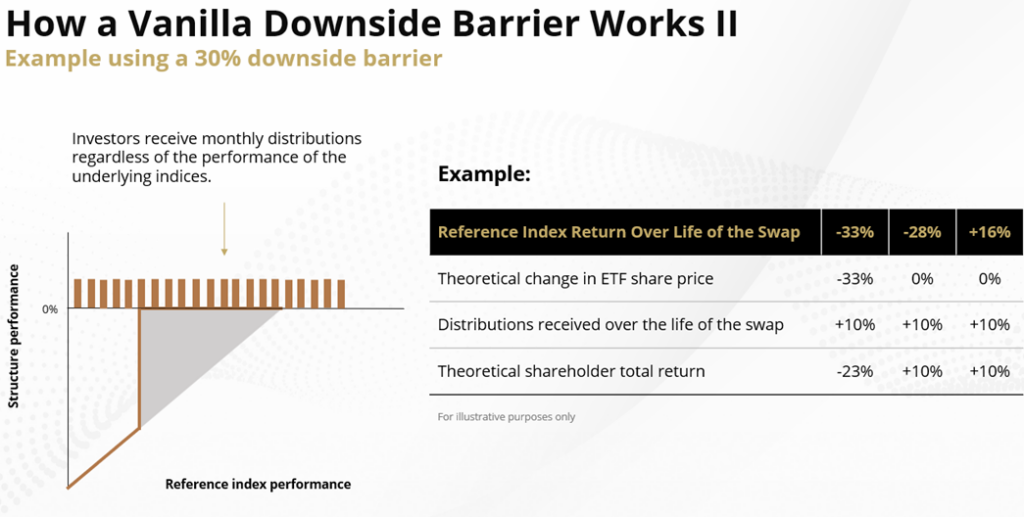Zinger Key Points
- SBAR utilizes a 30-barrier put option ladder, providing greater income potential compared to traditional fixed-income approaches.
- Meanwhile, XV aims to provide a 15% annualized distribution, remitted monthly.
- Don't face extreme market conditions unprepared. Get the professional edge with Benzinga Pro's exclusive alerts, news advantage, and volatility tools at 60% off today.
Simplify Asset Management has rolled out two innovative ETFs, the Simplify Barrier Income ETF SBAR and the Simplify Target 15 Distribution ETF XV, as it extends its lineup of options-based income solutions.
“The Simplify Barrier Income ETF and the Simplify Target 15 Distribution ETF offer a more flexible and streamlined alternative to traditional structured products by reducing bank credit risk, reducing compliance burdens, ensuring continuous liquidity, and seamlessly rolling into new vintages,” said Jeff Schwarte, chief equity strategist at Simplify.
These ETFs offer high monthly returns with well-defined risk parameters, the latest move in Simplify’s mission to reimagine structured income investing for the modern portfolio.
Also Read: Exclusive: Argent’s New ETFs Are Not Chasing AI Or Meme Stocks, Here’s What They’re Buying Instead
Central to both funds is a “worst-of-three” barrier put strategy. Each ETF writes barrier put options on the worst-performing of three equity index ETFs, which track U.S. large-cap, small-cap, and growth stocks. The premiums received on these options are subsequently paid out to shareholders as income. Downside risk is only encountered when the worst performer violates its barrier level at expiration, providing a structured means to capture income while retaining a disciplined risk profile.
"Selling a “worst-of” deep out of the money (OTM) barrier put option on a diversified basket of reference assets allows for the collection of higher premiums while maintaining a disciplined risk framework," said Schwarte. "This approach capitalizes on the low probability of the option being exercised, as it remains significantly OTM."
SBAR And XV Strategy Vs Traditional Bonds Or Covered Call Approaches
In a covered call writing, an investor holds a long position in an asset, such as stocks, and sells call options on the same asset. Schwarte explained that this strategy “generates additional income through the premiums received from selling the call options while providing downside protection to a limited extent, as the premium offsets potential losses. However, the trade-off is that the investor’s upside potential is capped, as the stock may be called away if its price exceeds the strike price of the call option.”
On the other hand, Schwarte explained that Simplify's new funds provide investors with a high monthly income through the sale of barrier put options, ensuring an attractive yield while maintaining risk mitigation.
SBAR utilizes a 30-barrier put option ladder, providing greater income potential compared to traditional fixed-income approaches. Investors give up a well-defined downside—only if the underlying index drops below the 30% level at expiration—while receiving increased yield opportunities by virtue of the deep out-of-the-money sold puts.
Meanwhile, XV aims to provide a 15% annualized distribution, remitted monthly. XV accomplishes this by dynamically shifting barrier levels in response to market conditions to supplement the yield target, while using a continually rolled ladder of swap contracts to flatten returns and dampen volatility shocks.
Vanilla Barrier Structure: Clarity Of Downside Risk
Both SBAR and XV employ what Schwarte calls a “vanilla downside barrier”—a simple, rules-based system that explicitly states the circumstances under which downside risk comes into play. This form of structure eschews the complexity and unpredictability frequently linked with exotic derivatives or structured notes.
By adopting this vanilla-style strategy and delivering it in a laddered format, the ETFs are attempting to give investors a smoother and more predictable income stream, diminishing the risk and administrative pain commonly associated with less transparent or path-dependent options strategies.

Built For Today’s Market Conditions
With higher interest rates, compressed credit spreads, and recession fears, SBAR and XV are debuting when conventional income strategies are facing severe headwinds. In contrast to long-duration bonds or volatility-selling ETFs, which are susceptible to overcrowding, Simplify’s new funds leverage bespoke swap agreements and ISDA relationships to enhance efficiency and execution. They also eschew the operational albatross of structured notes by removing bank credit risk, lock-up requirements, and K-1 tax forms.
Schwarte stressed that these ETFs provide all the advantages of a structured note without the baggage—No issuer solvency risk, no hard maturity dates—just clean, transparent access to structured income.
Diversification, Flexibility And Tactical Utility
Since both SBAR and XV roll their positions on a constant basis and include non-callable swap structures, they provide investors with flexibility to diversify sources of income or create a tactical allocation that offsets equity exposure and yield.
Schwarte said that SBAR and XV aim to offer high monthly income with built-in risk mitigation structures. Investors seeking enhanced yield may consider these ETFs as a differentiated source of income that complement existing strategies. “When paired with other Simplify income solutions—such as SVOL, BUCK, HIGH, MTBA, or CDX—they can contribute to a well-diversified, outcome-oriented income portfolio.”
With SBAR and XV, Simplify Asset Management is providing next-generation solutions for yield-oriented investors who want consistency, risk transparency, and operational ease. By combining institutional-quality strategy with the liquidity and flexibility of ETFs, Simplify is making these funds attractive alternatives or complements to traditional fixed income, perfectly positioned for today’s “higher for longer” world.
Read Next:
Photo: Shutterstock
Edge Rankings
Price Trend
© 2025 Benzinga.com. Benzinga does not provide investment advice. All rights reserved.
Trade confidently with insights and alerts from analyst ratings, free reports and breaking news that affects the stocks you care about.